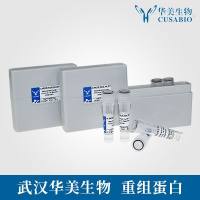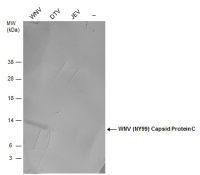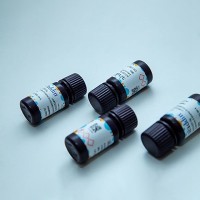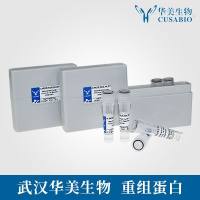Propagation, Quantification, Detection, and Storage of West Nile Virus
互联网
- Abstract
- Table of Contents
- Materials
- Figures
- Literature Cited
Abstract
West Nile virus (WNV) is a member of the Flaviviridae family of enveloped, single?stranded, positive?sense RNA viruses. WNV, an emerging viral pathogen, is transmitted by mosquitoes to birds and mammals and is responsible for an increasing incidence of human disease in North America and Europe. Due to its ease of use in the laboratory and the availability of robust mouse models of disease, WNV provides an excellent experimental system for studying molecular virology and pathogenesis of infection by flaviviruses. Here, we describe common laboratory techniques used to propagate, quantify, detect, and store WNV. We also briefly describe appropriate safety precautions required for the laboratory use of WNV, which is classified as a Biosafety Level 3 pathogen by the United States Centers for Disease Control and Prevention. Curr. Protoc. Microbiol . 31:15D.3.1?15D.3.18. ©2013 by John Wiley & Sons, Inc.
Keywords: West Nile virus; infection; titration; plaque assay; purification
Table of Contents
- Introduction
- Basic Protocol 1: Generation and Purification of West Nile Virus Stocks
- Basic Protocol 2: Quantification of WNV by Plaque Assay
- Basic Protocol 3: Determination of WNV RNA by Quantitative Fluorogenic Reverse‐Transcription PCR
- Basic Protocol 4: Viral Growth Curves
- Alternate Protocol 1: Quantification of WNV by Focus‐Forming Assay
- Support Protocol 1: Culturing BHK21 and Vero cells for WNV Propagation and Titering
- Support Protocol 2: Propagation of C6/36 Insect Cells
- Reagents and Solutions
- Commentary
- Literature Cited
- Figures
- Tables
Materials
Basic Protocol 1: Generation and Purification of West Nile Virus Stocks
Materials
Basic Protocol 2: Quantification of WNV by Plaque Assay
Materials
Basic Protocol 3: Determination of WNV RNA by Quantitative Fluorogenic Reverse‐Transcription PCR
Materials
Basic Protocol 4: Viral Growth Curves
Materials
Alternate Protocol 1: Quantification of WNV by Focus‐Forming Assay
Materials
Support Protocol 1: Culturing BHK21 and Vero cells for WNV Propagation and Titering
Materials
Support Protocol 2: Propagation of C6/36 Insect Cells
Materials
|
Figures
-
Figure 15.D0.1 Crystal violet–stained plaque assay plate. BHK21 cells were infected with 10‐fold dilutions of WNV, overlaid, and stained with crystal violet. Plaque counts were as follows: 10−2 to 10−4 , too numerous to count (TNTC); 10−5 , 118 plaques; 10−6 , 21 plaques; 10−7 , 2 plaques. The final viral titer was calculated to be 1.4 × 108 PFU/ml. View Image -
Figure 15.D0.2 Focus‐forming assay. Vero cells were infected with 10‐fold dilutions of WNV. Viral antigen was detected with an anti‐WNV MAb, followed by immunoperoxidase staining (purple). The highest‐concentration samples are in row A, with each row representing a 10‐fold dilution. Six samples were titered in duplicate (in adjacent columns). Viral titers were determined from wells with discrete foci (rows D to F). View Image
Videos
Literature Cited
| Literature Cited | |
| Bakonyi, T., Ferenczi, E., Erdelyi, K., Kutasi, O., Csorgo, T., Seidel, B., Weissenbock, H., Brugger, K., Ban, E., and Nowotny, N. 2013. Explosive spread of a neuroinvasive lineage 2 West Nile virus in Central Europe, 2008/2009. Vet. Microbiol. 165:61‐70. | |
| Bera, A.K., Kuhn, R.J., and Smith, J.L. 2007. Functional characterization of cis and trans activity of the Flavivirus NS2B‐NS3 protease. J. Biol. Chem. 282:12883‐12892. | |
| Bowen, R.A. and Nemeth, N.M. 2007. Experimental infections with West Nile virus. Curr. Opin. Infect. Dis. 20:293‐297. | |
| Brackney, D.E., Scott, J.C., Sagawa, F., Woodward, J.E., Miller, N.A., Schilkey, F.D., Mudge, J., Wilusz, J., Olson, K.E., Blair, C.D., and Ebel, G.D. 2010. C6/36 Aedes albopictus cells have a dysfunctional antiviral RNA interference response. PLoS Neglect. Trop. Dis. 4:e856. | |
| Briese, T., Rambaut, A., Pathmajeyan, M., Bishara, J., Weinberger, M., Pitlik, S., and Lipkin, W.I. 2002. Phylogenetic analysis of a human isolate from the 2000 Israel West Nile virus epidemic. Emerg. Infect. Dis. 8:528‐531. | |
| Brinton, M.A. 2002. The molecular biology of West Nile Virus: A new invader of the western hemisphere. Annu. Rev. Microbiol. 56:371‐402. | |
| Castillo‐Olivares, J. and Wood, J. 2004. West Nile virus infection of horses. Vet. Res. 35:467‐483. | |
| Castle, E., Leidner, U., Nowak, T., Wengler, G., and Wengler, G. 1986. Primary structure of the West Nile flavivirus genome region coding for all nonstructural proteins. Virology 149:10‐26. | |
| Chu, P.W. and Westaway, E.G., 1985. Replication strategy of Kunjin virus: Evidence for recycling role of replicative form RNA as template in semiconservative and asymmetric replication. Virology 140:68‐79. | |
| Daffis, S., Lazear, H.M., Liu, W.J., Audsley, M., Engle, M., Khromykh, A.A., and Diamond, M.S. 2011. The naturally attenuated Kunjin strain of West Nile virus shows enhanced sensitivity to the host type I interferon response. J. Virol. 85:5664‐5668. | |
| Diamond, M.S., Shrestha, B., Marri, A., Mahan, D., and Engle, M. 2003. B cells and antibody play critical roles in the immediate defense of disseminated infection by West Nile encephalitis virus. J. Virol. 77:2578‐2586. | |
| Fields, B.N., Knipe, D.M., Howley, P.M., and Griffin, D.E. 2001. Fields' Virology, 4th ed. Lippincott Williams & Wilkins, Philadelphia. | |
| Han, L.L., Popovici, F., Alexander, J.P., Jr., Laurentia, V., Tengelsen, L.A., Cernescu, C., Gary, H.E., Jr., Ion‐Nedelcu, N., Campbell, G.L., and Tsai, T.F. 1999. Risk factors for West Nile virus infection and meningoencephalitis, Romania, 1996. J. Infect. Dis. 179:230‐233. | |
| Hayes, C.G. 2001. West Nile virus: Uganda, 1937, to New York City, 1999. Ann. N.Y. Acad. Sci. 951:25‐37. | |
| Heinz, F.X. and Allison, S.L. 2000. Structures and mechanisms in flavivirus fusion. Adv. Virus Res. 55:231‐269. | |
| Hubalek, Z. and Halouzka, J. 1999. West Nile fever―a reemerging mosquito‐borne viral disease in Europe. Emerg. Infect. Dis. 5:643‐650. | |
| Jia, X.‐Y., Briese, T., Jordan, I., Rambaut, A., Chang Chi, H., Mackenzie, J.S., Hall, R.A., Scherret, J., and Lipkin, W.I. 1999. Genetic analysis of West Nile New York 1999 encephalitis virus. Lancet 354:1971‐1972. | |
| Lanciotti, R.S., Roehrig, J.T., Deubel, V., Smith, J., Parker, M., Steele, K., Crise, B., Volpe, K.E., Crabtree, M.B., Scherret, J.H., Hall, R.A., MacKenzie, J.S., Cropp, C.B., Panigrahy, B., Ostlund, E., Schmitt, B., Malkinson, M., Banet, C., Weissman, J., Komar, N., Savage, H.M., Stone, W., McNamara, T., and Gubler, D.J. 1999. Origin of the West Nile virus responsible for an outbreak of encephalitis in the northeastern United States. Science 286:2333‐2337. | |
| Lanciotti, R.S., Kerst, A.J., Nasci, R.S., Godsey, M.S., Mitchell, C.J., Savage, H.M., Komar, N., Panella, N.A., Allen, B.C., Volpe, K.E., Davis, B.S., and Roehrig, J.T. 2000. Rapid detection of West Nile virus from human clinical specimens, field‐collected mosquitoes, and avian samples by a TaqMan reverse transcriptase‐PCR assay. J. Clin. Microbiol. 38:4066‐4071. | |
| Lanciotti, R.S., Ebel, G.D., Deubel, V., Kerst, A.J., Murri, S., Meyer, R., Bowen, M., McKinney, N., Morrill, W.E., Crabtree, M.B., Kramer, L.D., and Roehrig, J.T. 2002. Complete genome sequences and phylogenetic analysis of West Nile virus strains isolated from the United States, Europe, and the Middle East. Virology 298:96‐105. | |
| Lazear, H.M., Lancaster, A., Wilkins, C., Suthar, M.S., Huang, A., Vick, S.C., Clepper, L., Thackray, L., Brassil, M.M., Virgin, H.W., Nikolich‐Zugich, J., Moses, A.V., Gale, M., Jr., Fruh, K., and Diamond, M.S. 2013. IRF‐3, IRF‐5, and IRF‐7 coordinately regulate the Type I IFN response in myeloid dendritic cells downstream of MAVS signaling. PLoS Pathog. 9:e1003118. | |
| May, F.J., Davis, C.T., Tesh, R.B., and Barrett, A.D. 2011. Phylogeography of West Nile virus: From the cradle of evolution in Africa to Eurasia, Australia, and the Americas. J. Virol. 85:2964‐2974. | |
| McMullen, A.R., Albayrak, H., May, F.J., Davis, C.T., Beasley, D.W., and Barrett, A.D. 2013. Molecular evolution of lineage 2 West Nile virus. J. Gen. Virol. 94:318‐325. | |
| Oliphant, T., Engle, M., Nybakken, G.E., Doane, C., Johnson, S., Huang, L., Gorlatov, S., Mehlhop, E., Marri, A., Chung, K.M., Ebel, G.D., Kramer, L.D., Fremont, D.H., and Diamond, M.S. 2005. Development of a humanized monoclonal antibody with therapeutic potential against West Nile virus. Nat. Med. 11:522‐530. | |
| Papa, A., Xanthopoulou, K., Gewehr, S., and Mourelatos, S. 2011. Detection of West Nile virus lineage 2 in mosquitoes during a human outbreak in Greece. Clin. Microbiol. Infect. 17:1176‐1180. | |
| Sejvar, J.J., Haddad, M.B., Tierney, B.C., Campbell, G.L., Marfin, A.A., Van Gerpen, J.A., Fleischauer, A., Leis, A.A., Stokic, D.S., and Petersen, L.R. 2003. Neurologic manifestations and outcome of West Nile virus infection. JAMA 290:511‐515. | |
| Smit, J.M., Moesker, B., Rodenhuis‐Zybert, I., and Wilschut, J. 2011. Flavivirus cell entry and membrane fusion. Viruses 3:160‐171. | |
| Tsai, T.F., Popovici, F., Cernescu, C., Campbell, G.L., and Nedelcu, N.I. 1998. West Nile encephalitis epidemic in southeastern Romania. Lancet 352:767‐771. | |
| van der Meulen, K.M., Pensaert, M.B., and Nauwynck, H.J. 2005. West Nile virus in the vertebrate world. Arch. Virol. 150:637‐657. | |
| Wengler, G., Wengler, G., Nowak, T., and Wahn, K. 1987. Analysis of the influence of proteolytic cleavage on the structural organization of the surface of the West Nile flavivirus leads to the isolation of a protease‐resistant E protein oligomer from the viral surface. Virology 160:210‐219. | |
| Zhang, Y., Kaufmann, B., Chipman, P.R., Kuhn, R.J., and Rossmann, M.G. 2007. Structure of immature West Nile virus. J. Virol. 81:6141‐6145. |







